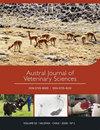Assessment of the CPL-0015 isolate as a vaccine strain for the control of canine parvovirus in Cuba
IF 0.8
4区 农林科学
Q3 VETERINARY SCIENCES
引用次数: 0
Abstract
. The safety and protective efficacy of the CPL-0015 Cuban isolate of canine parvovirus type 2 (CPV-2) were evaluated for its possible use as a vaccine strain candidate. The study included a total of 23 healthy Beagle dogs of both sexes, aged 84 days and without specific maternal antibodies against canine parvovirus. Safety was analysed by comparing clinicopathological values, food consumption, body weight, rectal temperature and white blood cell counts for 14 consecutive days between control dogs (n=5) and dogs subcutaneously injected (n=10) with 2 mL (equivalent to two doses) of the CPL-0015 strain with an antigenic titer of 10 6.0 infectious dose 50 in cell culture/mL. The protective effectiveness was determined by measuring and comparing anti-CPV-2 IgG levels and clinical signs during 56 experimental days between control dogs (n=2) and dogs inoculated (n=6) with double doses of 1 mL each, separated by a 21-day interval. All animals were challenged orally on day 35 with the virulent strain Cornell-780916 (10 5.0 infective dose 50 in cell culture/mL). The results showed that the CPL-0015 strain did not negatively impact the physiological condition of the exposed animals. The inoculated and challenged animals showed not only significantly increased levels of anti-CPV-2 IgG ( P <0.05) when compared to days 0, 35, and the control group animals but also had 100% survival without clinical signs of the disease, unlike the control group. It is concluded that CPL-0015 is safe and provides effective protection against homologous virulent strains.CPL-0015分离株作为控制古巴犬细小病毒疫苗株的评估
. 对CPV-2型犬细小病毒古巴分离株CPL-0015的安全性和保护效果进行了评价,以确定其作为候选疫苗株的可能性。这项研究包括23只健康的男女比格犬,年龄84天,没有针对犬细小病毒的特异性母体抗体。通过对比对照犬(n=5)和皮下注射2 mL(相当于2剂量)CPL-0015菌株(细胞培养物感染剂量50 /mL)连续14天的临床病理学值、食用量、体重、直肠温度和白细胞计数,分析其安全性。在56天的实验期间,通过检测和比较对照犬(n=2)和接种犬(n=6)的抗cpv -2 IgG水平和临床症状,每双剂量1 mL,间隔21天。所有动物于第35天口服毒力菌株Cornell-780916(细胞培养物感染剂量50 /mL)。结果表明,CPL-0015菌株对暴露动物的生理状况没有负面影响。与对照组相比,接种和攻毒动物不仅抗cpv -2 IgG水平显著升高(P <0.05),而且与对照组相比,接种和攻毒动物的存活率为100%,无临床症状。结果表明,CPL-0015是安全的,对同源毒株具有有效的保护作用。
本文章由计算机程序翻译,如有差异,请以英文原文为准。
求助全文
约1分钟内获得全文
求助全文
来源期刊

Austral Journal of Veterinary Sciences
Veterinary-General Veterinary
CiteScore
1.60
自引率
0.00%
发文量
18
期刊介绍:
Austral Journal of Veterinary Sciences (formerly Archivos de Medicina Veterinaria) publishes original scientific contributions in English, containing the latest developments and discoveries in veterinary sciences. The journal covers topics such as animal health and production, preventive medicine, zoonosis, pharmacology and therapeutics, methods of diagnosis, and other areas related to the veterinary field.
Austral Journal of Veterinary Sciences aims to divulge information about advances in veterinary medicine among universities, research centres, industries, government agencies, biologists, agronomists and veterinarians.
 求助内容:
求助内容: 应助结果提醒方式:
应助结果提醒方式:


